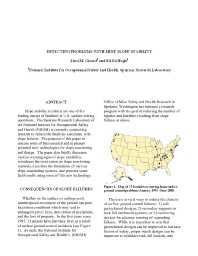Mining Publication: Detecting Problems With Mine Slope Stability
Original creation date: August 2002
Slope stability accidents are one of the leading causes of fatalities at U.S. surface mining operations. The Spokane Research Laboratory of the National Institute for Occupational Safety and Health (NIOSH) is currently conducting research to reduce the fatalities associated with slope failures. The purpose of this paper to discuss some of this research and to present potential new technologies for slope monitoring and design. The paper also briefly discusses various warning signs of slope instability, introduces the most common slope monitoring methods, describes the limitations of various slope monitoring systems, and presents some field results using some of this new technology.
Authors: JM Girard, EL McHugh
Conference Paper - August 2002
NIOSHTIC2 Number: 20030015
31st Annual Institute on Mining Health, Safety, and Research, Roanoke, VA, Aug. 27-30, 2000; :8 pp
See Also
- Advances in Remote Sensing Techniques for Monitoring Rock Falls and Slope Failures
- Analysis of Bench Crest Performance at the Yellowstone Mine: A Case Study
- Applications of Ground-Based Radar to Mine Slope Monitoring
- Applications of Ground-Based Radar to Mine Slope Monitoring
- Applications of the Point Estimation Method for Stochastic Rock Slope Engineering
- Assessing and Monitoring Open Pit Mine Highwalls
- Current Research on Slope Movement in Mines: Use of Hyperspectral Imagery
- Evaluating Techniques for Monitoring Rock Falls and Slope Stability
- Slope Stability
- A User's Guide for the Bplane, Bstepp, and Bwedge Computer Programs
- Page last reviewed: 9/21/2012
- Page last updated: 9/21/2012
- Content source: National Institute for Occupational Safety and Health, Mining Program


 ShareCompartir
ShareCompartir
